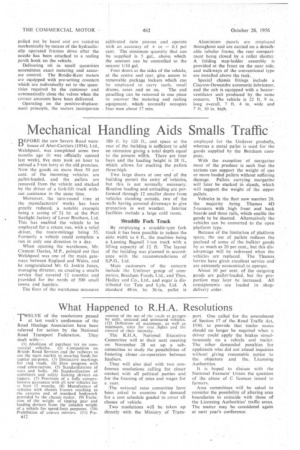Mechanical Handling Aids Smalls Traffic
Page 46

If you've noticed an error in this article please click here to report it so we can fix it.
DEFORE the new Severn Road ware house of Aber-Carriers (1954), Ltd., Welshpool, was completed some two months ago (it was officially opened last week), five men took an hour to unload a 5-ton lorry at the old premises. Now the goods on more than 50 per cent, of the incoming vehicles are pallet-loaded, and the pallets are removed from the vehicle and stacked by the driver a a fork-lift truck without assistance in the same time.
Moreover, the turn-round time at the manufacturers' works has been greatly reduced, a notable example being a saving of' 2+ hr. at the Port Sunlight factory of Lever Brothers, Ltd. This has enabled the vehicle to be employed for a return run, with a relief driver, the route-mileage being 55. Formerly a vehicle could complete a run in only one direction in a day.
When opening the warehouse, Mr. Clement Davies, M.P., pointed out that Welshpool was one of the main gateways between England and Wales, and he congratulated Mr. G. Jenkin Jones, managing director, on creating a smalls service that covered 12 counties and provided for the needs of 500 small towns and hamlets.
The floor of the warehouse measures 180 ft. by 120 ft., and space at the rear of the building is sufficient to add an extension giving a total depth equal to the present wrath. There are four bays and the loading height is 18 ft., which allows for stacking the pallets three-high.
Two large doors at one end of the building permit the entry of vehicles, but this is not normally necessary. Routine loading and unloading are performed through 12 smaller doors from vehicles standing outside, two of the walls having covered driveways to give protection in wet weather. Interior facilities include a large cold room.
Straddle Fork Truck
By employing a straddle-type fork truck it has been possible to reduce the aisle width to 6 ft., the machine being a Lansing Bagnall 1-ton truck with a lifting capacity of 12 ft. The layout of the building was planned in accordance with the recommendations of S.P.D., Ltd, Main customers of the concern include the Unilever group of companies, Beecham Foods, Ltd., and Thos. Hedley and Co., Ltd., and sugar is distributed for Tate and Lyle, Ltd. A standard 48-in. by 36-in, pallet is employed for the Unilever products, whereas a metal pallet is used for the goods supplied by the Beecham company.
With the exception of margarine most of the produce is such that the cartons can support the weight of one or more loaded pallets without suffering damage. Pallets carrying margarine will later be stacked in stands, which will support the weight of the upper pallets.
Vehicles in the fleet now number 20. the majority being Thames 4D 5-tonners with .high front and back boards and three rails, which enable the goods to be sheeted. Alternatively the vehicles can be converted to the open platform type.
Because of the limitation of platform space, the use of pallets reduces the payload of some of the bulkier goods by as much as 20 per cent., but this disadvantage will be redressed when the vehicles are replaced. The Thames lorries have given excellent service and are extremely economical to operate.
About 10 per cent. of the outgoing goods are pallet-loaded, but the proportion may later be increased. All consignments are loaded in shopdelivery order.




































































































